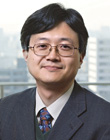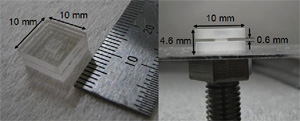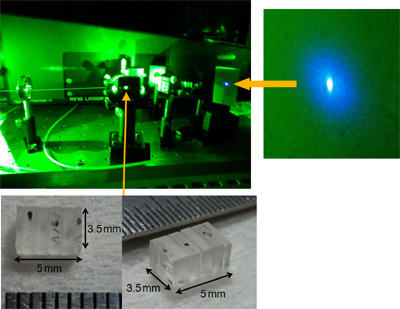Top>Research>Realizing a unique laser using original technology
 Index
Index

Ichiro Shoji [Profile]
Education Course
Realizing a unique laser using original technology
Ichiro Shoji
Professor of Lasers, Nonlinear Optics, Faculty of Science and Engineering, Chuo University
Foreword-What is laser?-
Laser was created in 1960, and last year saw many events, both in and out of Japan, celebrating its 50th anniversary. At the moment, laser is used in a wide range of fields, starting with manufacturing, medicine and measuring. In particular, because lasers diodes are compact and consume little electric power, they are used in everyday items around us such as CDs, DVDs, and Blu-ray disc players, laser printers, barcode readers, and laser pointers.
The light emitted from lasers holds different properties to those from the sun, light bulbs and fluorescent lights. Light other than laser comprises of various continuous colours (wavelengths) that spreads out in every direction. On the other hand, laser light comes from a single wavelength and proceeds in a specific direction. This kind of good quality light (the technical term is "coherent") can concentrate energy on an extremely small area. In this way it is possible to cut through a steel plate, scrape away part of the cornea in order to correct short-sightedness, send a laser beam to the surface of the moon and measure the distance to the moon, and read information stored on a optical disc smaller than 1/1000th of a millimeter in size.
Conditions for high-performance lasers
In these ways, lasers are already being used as a useful tool in many areas. But I would like to point out that the potential of lasers doesn't end there. I think that by skillfully extracting that potential, we can open up a whole new world.
I wrote that laser light is of high quality compared to other light, but in laser today, when output is increased, quality decreases. In other words, it is impossible to produce high quality laser with high output power. In addition to that, another point is that its high energy efficiency and ease of use in small-scale objects makes it practical. Furthermore, the wavelength of laser is also important. The reaction of light irradiated on objects differs greatly depending on wavelength, so lasers oscillating at various wavelengths are required to meet the purpose of its use.
An approach to realization of high-performance lasers
Our group is conducting research with the ultimate goal of realizing lasers that satisfy the above conditions. We have specifically set the following two points as key factors for high-performance lasers
- Selecting laser materials most suitable for our purpose.
- Designing and developing laser configurations to extract the highest performance.
In regards to the first point, we are currently developing new laser materials, and even though we aren't using them at the present point in time, we have promising materials that will stand out in the future. There, our group has been conducting precise evaluations on the optical characteristics of many types of materials, and using them as basic data when designing lasers. This data has been recognized as highly reliable by researchers from all over the world, and as of July 27, 2011, an article summarizing this data has been cited 238 times.
There are many points to be taken into consideration regarding the second point about optimal laser configurations. One of the most important elements is in what form to process the laser materials to be used as devices.
Recently, our group has been putting efforts into developing laser devices by use of room-temperature bonding, which would be core technology that makes it possible to realize never-seen-before high-performance laser. Below, I will introduce recently developed devices and results.
New devices using room-temperature bonding
-Room-temperature bonding-
When developing laser devices, by integrating multiple materials, new functions are created and high-efficiency can be measured. Generally, when we stick things together we use adhesives, but these can not be used on laser devices. That is because adhesives absorb and scatters laser light, resulting in a great reduction of output. Therefore, it is necessary to join materials directly without using adhesives.
Up until now, diffusion bonding has been used, a method where materials are joined in high temperatures of several hundreds of degrees. With high temperatures, it is easy for a chemical reaction to occur in the atoms, and the surface of the atoms in contact with each other fuse together. But, in addition to quality being degraded under high temperatures, another problem that arose was separation after cooling down when the thermal expansion of bonded materials was different.
On the other hand, with room-temperature bonding, argon atoms collide with the material surface in a room-temperature vacuum and remove the oxygen atoms from the surface. In doing so, the atoms that appear on the surface of the material become highly susceptible to chemical reaction, and fuse together at an atomic level without raising the temperature. Therefore, with this method, the material's quality is preserved and it has the outstanding advantage of being able to join materials with different thermal expansion rates.
This technology itself was developed by a group from The University of Tokyo, but our group is the first to apply it to laser devices that passe light through the bonded surfaces, and at the moment, is the only one of its kind in the world.
-Developing high output lasers-

Figure 1. Composite laser fabricated by bonding Yb:YAG and YAG
As an example, a laser material called Yb-doped YAG (Yb:YAG) can accumulate large amounts of energy and release it all at once, but it has a problem where the temperature rises due to the heat from the laser operation, resulting in decreased efficiency. There, by bonding non-heat generating materials called undoped YAG to both sides of Yb:YAG, a structure where heat generated in Yb:YAG is discharged into YAG is created by room-temperature bonding (Figure 1). The advantage of this method, as opposed to the traditional fusion method using a high temperature process where difficulties arise when materials with different thermal expansion coefficients are bonded, is that the type of material used in the room-temperature process does not come into question. In the future, if we can realize high-energy operation by creating composite structures using materials with superior heat conductivity, I believe it will be possible to effectively ignite gas engines for cogeneration by laser.
These results were presented by Graduate School students at the Advanced Solid-State Photonics Topical Meeting(ASSP2011)held in Istanbul in February.
-Developing ultraviolet lasers-
The room-temperature bonding is also very effective when developing lasers which operate at various wavelengths. Because there is a limit of types of laser materials, there is also a limit to the number of wavelengths that laser can output directly. In that area, research into changing various wavelengths of laser light is currently being undertaken by passing light from existing laser through a wavelength-conversion device. When doing this, in order to increase the efficiency of wavelength conversion, it is necessary to create a structure in which the direction of the material periodically changes. Until now, several methods have been proposed, but the all had the problem where there was a restriction to applicable material. However, because room-temperature bonding theoretically allows application to any material, and until now, even when the potential for wavelength conversion is high, there has been no method of fabricating devices, it has become possible to use materials which previously gained little attention. This can also be applied to materials which lose quality in the high temperature process.

Figure 2. High-efficiency deep ultraviolet light wavelength converter and ultraviolet laser light created
Our group has recently succeeded in developing a device which effectively generates ultraviolet light through wavelength conversion using a material called BBO. BBO is originally a highly efficient material that generates ultraviolet light, but there was the problem where, when it is used on its own, the ultraviolet light which is generated from the incident laser light (green colour) inside the crystal is separated from the incident green laser, so that the output of the ultraviolet light is greatly reduced. To overcome this problem, in addition to periodically reversing the direction of BBO and returning the separated beam to its original position, we have newly developed a structure where the separation of the beam is halved through the addition of half the thickness of BBO to both ends. And, through fabrication and evaluation of actual devices using room-temperature bonding, we have confirmed the creation of double the amount of ultraviolet light compared to pre-structurization (Figure 2). If we further improve the structure in the future, I believe it is possible to increase output ten-fold. Ultraviolet light has become indispensable in the semiconductor and biotechnology fields where miniaturization is advancing increasingly, and will have a huge impact if realized.
These results were presented orally (in English, of course) by graduate school students to a gathering of top-class researchers from the world over at the Nonlinear Optics International Conference (NLO 2011) held in Hawaii in July. There was a lot of interest shown and at the end of the presentation, researchers from the world's largest laser makers spent a long time asking details, as well as domestic researchers offering to conduct joint research. The Nikkei Sangyo Shimbun and The Nikkan Kogyo Shimbun also published our results along with photographs.
Conclusion
The special characteristic of room-temperature bonding is versatility that it is possible to bond various materials. Room-temperature bonding has made materials that, up until now, had no method to be transformed into devices while maintaining their potential capacity as laser materials, possible. There are still many issues that need resolving, but while clearing each hurdle while continuing research in the future, I would like to present to the world, even if only one, laser that is truly useful.
- Ichiro Shoji
Professor of Lasers, Nonlinear Optics, Faculty of Science and Engineering, Chuo University - Born in Muroran City, Hokkaido in 1969. Graduated from the Department of Applied Physics, Faculty of Engineering, The University of Tokyo in 1992. Completed his Master's Degree at the Department of Applied Physics, Graduate School of Engineering, The University of Tokyo in 1994. Left the Department of Applied Physics, Graduate School of Engineering, The University of Tokyo doctorate course in 1995.
Ph.D. (Engineering, The University of Tokyo)
Started working at Chuo University in 2004 after spending time as a research associate at the University of Tokyo and Institute for Molecular Science. After taking positions of full-time lecturer and associate professor, took up his current post in 2010.
Involved in research and development of high-performance compact lasers using original technology.
- Research Activities as a Member of Research Fellowship for Young Scientists (DC1), Japan Society for the Promotion of Science (JSPS) Shuma Tsurumi
- Important Factors for Innovation in Payment Services Nobuhiko Sugiura
- Beyond the Concepts of Fellow Citizens and Foreigners— To Achieve SDGs Goal 10 “Reduce Inequality Within and Among Countries” Rika Lee
- Diary of Struggles in Cambodia Fumie Fukuoka
- How Can We Measure Learning Ability?
—Analysis of a Competency Self-Assessment Questionnaire— Yu Saito / Yoko Neha - The Making of the Movie Kirakira Megane








